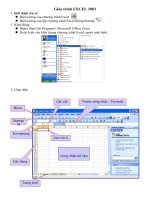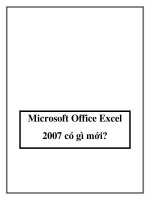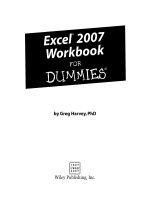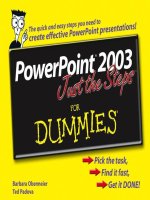microsoft office excel 2003
Bạn đang xem bản rút gọn của tài liệu. Xem và tải ngay bản đầy đủ của tài liệu tại đây (3.01 MB, 30 trang )
New Perspectives
on Microsoft Office Excel
2003 Tutorial 1
1
XP
Microsoft Office Excel 2003
Tutorial 1 – Using Excel To Manage Data
New Perspectives
on Microsoft Office Excel
2003 Tutorial 1
2
XP
Identify major components
of the Excel window
•
Excel is a computerized spreadsheet, which is an important
business tool that helps you report and analyze information.
•
Excel stores spreadsheets in documents called workbooks.
•
Each workbook is made up of individual worksheets, or
sheets.
•
Because all sorts of calculations can be made in the Excel
spreadsheet, it is much more flexible than a paper
spreadsheet.
•
The Excel window has some basic components, such as an
Active cell, Column headings, a Formula bar, a Name box,
the mouse pointer, Row headings, Sheet tabs, a Task Pane,
Tab scrolling buttons and Toolbars.
New Perspectives
on Microsoft Office Excel
2003 Tutorial 1
3
XP
A sample Excel worksheet
New Perspectives
on Microsoft Office Excel
2003 Tutorial 1
4
XP
Excel worksheets and workbooks
•
When you set up calculations in a worksheet, if an
entry is changed in a cell, the spreadsheet will
automatically update any calculated values that were
based on that entry.
•
When you open Excel, by default it will open a
blank workbook with three blank worksheets.
•
When you save a workbook, you have a Save As
option that can save the spreadsheet to earlier
versions of Excel or to Quattro Pro, Lotus 123
formats, dBase formats, and even to a comma or
tab-delimited text file.
New Perspectives
on Microsoft Office Excel
2003 Tutorial 1
5
XP
Identify Excel components
New Perspectives
on Microsoft Office Excel
2003 Tutorial 1
6
XP
Descriptions of Excel components
New Perspectives
on Microsoft Office Excel
2003 Tutorial 1
7
XP
Navigate within worksheets
•
To navigate within a workbook, you use the arrow
keys, PageUp, PageDown, or the Ctrl key in
combination with the arrow keys to make larger
movements.
•
The most direct means of navigation is with your
mouse.
•
Scroll bars are provided and work as they do in all
Windows applications.
New Perspectives
on Microsoft Office Excel
2003 Tutorial 1
8
XP
Navigate between worksheets
•
To move to other Worksheets, you can:
–
Click their tab with the mouse
–
Use the Ctrl key with the Page Up and Page Down keys
to move sequentially up or down through the
worksheets
•
If you are familiar with Microsoft Access, you
will find the tab scrolling buttons for moving
between worksheets to be similar to record
browsing on an Access form or datasheet.
New Perspectives
on Microsoft Office Excel
2003 Tutorial 1
9
XP
Navigation keystrokes
New Perspectives
on Microsoft Office Excel
2003 Tutorial 1
10
XP
The Active Cell
New Perspectives
on Microsoft Office Excel
2003 Tutorial 1
11
XP
Developing a Worksheet
•
Determine the worksheet’s purpose.
•
Enter the data and formulas.
•
Test the worksheet and make any necessary edits /
corrections.
•
Document the worksheet and improve appearance.
•
Save and print the complete worksheet.
New Perspectives
on Microsoft Office Excel
2003 Tutorial 1
12
XP
Entering Data into a Worksheet
•
To enter data, first make the cell in which you
want to enter the data active by clicking it.
•
Enter the data (text, formulas, dates, etc.) into the
active cell.
•
Use the Alt+Enter key combination to enter text
on multiple lines within the same cell.
•
Use TAB key, arrow keys, or ENTER key to
navigate among the cells.
New Perspectives
on Microsoft Office Excel
2003 Tutorial 1
13
XP
Entering Data into a Worksheet
New Perspectives
on Microsoft Office Excel
2003 Tutorial 1
14
XP
Entering Formulas
•
A formula is a mathematical expression that
calculates a value.
•
In Excel, formulas always begin with an equal
sign (=).
•
A formula can consist of one or more arithmetic
operators.
•
The order of precedence is a set of predefined
rules that Excel follows to calculate a formula.
New Perspectives
on Microsoft Office Excel
2003 Tutorial 1
15
XP
Arithmetic Operators
New Perspectives
on Microsoft Office Excel
2003 Tutorial 1
16
XP
Order of Precedence Rules
New Perspectives
on Microsoft Office Excel
2003 Tutorial 1
17
XP
Resize worksheet rows and columns
•
There are a number of methods for altering row height and
column width using the mouse or menus:
–
Click the dividing line on the column or row, and drag the
dividing line to change the width of the column or height of the
row
–
Double-click the border of a column heading, and the column will
increase in width to match the length of the longest entry in the
column
•
Widths are expressed either in terms of the number of
characters or the number of screen pixels.
New Perspectives
on Microsoft Office Excel
2003 Tutorial 1
18
XP
Resize a column
New Perspectives
on Microsoft Office Excel
2003 Tutorial 1
19
XP
Identify cell ranges
•
A group of worksheet cells is known as a cell range, or
range.
•
Working with ranges in a worksheet makes working with
the data easier.
•
Ranges can be adjacent or nonadjacent.
–
An adjacent range is a single, rectangular block of cells
–
Select an adjacent range by clicking on a cell and dragging to an
opposite corner of a rectangle of cells
–
A nonadjacent range is comprised of two or more adjacent ranges
that are not contiguous to each other
–
To select a nonadjacent range, begin by selecting an adjacent
range, then press and hold down the Ctrl key as you select other
adjacent ranges
New Perspectives
on Microsoft Office Excel
2003 Tutorial 1
20
XP
Select and move worksheet cells
•
To select a large area of cells, select the first cell in the
range, press and hold the Shift key, and then click the last
cell in the range.
•
Once you have selected a range of cells, you may move the
cells within the worksheet by clicking and dragging the
selection from its current location to its new one.
•
By pressing and holding the Ctrl key as you drag, Excel
will leave the original selection in its place and paste a
copy of the selection in the new location.
•
To move between workbooks, use the Alt key while
dragging the selection.
New Perspectives
on Microsoft Office Excel
2003 Tutorial 1
21
XP
Adjacent and nonadjacent ranges
New Perspectives
on Microsoft Office Excel
2003 Tutorial 1
22
XP
Range selection techniques
New Perspectives
on Microsoft Office Excel
2003 Tutorial 1
23
XP
Moving selected cell ranges
New Perspectives
on Microsoft Office Excel
2003 Tutorial 1
24
XP
Insert worksheet rows and columns
•
You can insert one or many additional rows or
columns within a worksheet with just a few steps
using the mouse or menu options.
•
You can insert individual cells within a row or
column and then choose how to displace the
existing cells.
•
You can click the Insert menu and then select row
or column, or right click on a row or column
heading or a selection of cells and then choose
Insert from the shortcut menu.
New Perspectives
on Microsoft Office Excel
2003 Tutorial 1
25
XP
Delete worksheet rows and columns
•
To delete and clear cells, rows, or columns, you
can use the Edit menu, or right click on a heading
or a selection of cells and choose Delete from the
shortcut menu.
•
Clearing, as opposed to deleting, does not alter the
structure of the worksheet or shift uncleared data
cells.
•
What can be confusing about this process is that
you can use the Delete key to clear cells, but it
does not remove them from the worksheet as you
might expect.









